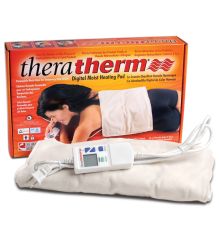Frozen Shoulder
Adhesive capsulitis, which is commonly referred to as frozen shoulder, is a condition in which certain parts of the shoulder get swollen and stiff. This causes pain and limits the ability to move and rotate the shoulder normally, as if it were “frozen.” Frozen shoulder is more common in females than in males, and typically affects people between the ages of 40-60. In most cases it only occurs in one shoulder, but some people experience it in both.
What causes frozen shoulder?
The shoulder is a ball-and-socket joint, where the round part of the upper arm bone (humerus) fits like a ball in the “socket” of the shoulder blade (scapula). These bones and all the other structures of the joint are surrounded by the shoulder capsule, which is made up of strong connective tissue that helps keep the shoulder stable. Frozen shoulder occurs when scar tissue forms in the shoulder, which causes this capsule to thicken and tighten around the shoulder joint. (As a result, there is less room for regular movement and it becomes difficult and painful to move the shoulder.)
Frozen shoulder occurs in about 2-5% of the population, but the reason it develops is still not completely understood and continues to be debated by some. In general, it’s believed that not moving the shoulder joint normally for a long period of time is a leading factor. Most people who get frozen shoulder have had to keep their shoulder immobilized due to a recent injury, surgery, pain or some other health condition. Injuries like shoulder bursitis, shoulder tendonitis or a broken arm can all restrict shoulder motion—or prevent it from moving completely—and frozen shoulder may develop as a result. Other risk factors include the following:
- Age: the condition is more likely to occur between ages 40-60
- Gender: 70% of patients with frozen shoulder are female
- Diabetes: diabetics are 2-4 times more likely to get frozen shoulder, and symptoms may be more severe for them
- Inflammation: conditions like arthritis can increase the risk
- Systemic diseases: hypothyroidism, hyperthyroidism, cardiovascular disease and Parkinson’s disease may also increase risk
- Stroke: people who have suffered a stroke may be at a higher risk as well
What are the symptoms?
Frozen shoulder develops slowly and gets progressively worse over time with more pain and loss of motion. Its progress is typically broken down into the following four stages:
Stage 1: Pre-freezing
Symptoms start at this stage and gradually get worse over the course of 1-3 months.
- There is usually an ache over the outer shoulder felt during the day and at night that becomes sharper when you try to move it
- It will also start to become more difficult to move the shoulder, especially when rotating, raising the arm or reaching behind the back
Stage 2: Freezing
Generally occurs 3-9 months after the start of symptoms.
- At this point, any movement of the shoulder causes pain
- Pain becomes even worse at night
- The range of motion, or flexibility of the shoulder also starts to become more limited
Stage 3: Frozen
The “frozen” stage occurs within 9-14 months.
- The shoulder becomes more stiff, making it more difficult to move and rotate it
- The beginning of this stage may still be painful, but pain will gradually level off or start to decrease by the end of it
- Pain usually only occurs when you move your shoulder as far as possible
Stage 4: Thawing
The final stage occurs within 12-15 months.
- Pain decreases significantly, especially at night
- Range of motion begins to improve, which makes it easier to move the shoulder and complete overhead tasks
- Eventually, each patient will return to their normal strength and flexibility levels, but this can take at least one year or longer
What is the treatment?
If you experience symptoms of frozen shoulder that seem to be getting progressively worse, you should see a medical professional like a physical therapist to determine what the problem is. To diagnose your condition, he or she will ask you some questions about your symptoms and perform a detailed examination of your shoulder. They will have you try to move your shoulder in multiple directions, and will then do the same thing themselves to determine your pain and flexibility levels. In some cases, additional tests like an x-ray or MRI may be needed to confirm the diagnosis and rule out any other possible causes of symptoms.
Most cases of frozen shoulder will get better on their own, but it usually takes one year or longer to fully recover. Treating the pain and symptoms can help to speed up the recovery process, and about 90% of patients will improve after following a course of conservative (non-surgical) options.
Physical therapy
Physical therapy is one conservative treatment that is commonly recommended, since it is known to be effective for managing symptoms. The goal of physical therapy is to control pain and improve strength and flexibility to help patients move their shoulder more easily. Treatment is based on your current stage of frozen shoulder:
Stages 1 & 2
The focus at this point will be to reduce pain and preserve the movement of your shoulder; course of action may include:
- Shoulder immobilization: when not performing rehab exercises, you should reduce movement in your shoulder as much as possible by wearing a sling – an ideal sling is the DonJoy Ultrasling IV which is comfortable and easy to use
- Stretching exercises: your therapist will have you perform basic and gentle exercises at first to improve the range of motion of your shoulder
- Manual therapy: your therapist may also use these techniques to manipulate and mobilize your shoulder to increase range of motion
- Heat and/or ice: heat or ice may be applied to the shoulder to relax your muscles before other treatments
- Home-exercise program: this may be assigned to help you retain the improvements you make in the office at your home
Stage 3
This stage of recovery will focus on helping you start to regain your normal range of motion
- Stretching exercises and manual therapy will continue, but will become more aggressive
- Strengthening exercises may also be added to your in-office and home-exercise program to build back up the strength of your shoulder
Stage 4
This stage focuses on helping you return to your normal daily activities
- Stretching exercises, strengthening exercises and manual therapy will all continue to progress and become more intense
- If you struggle with any particular activities or sports, your therapist will have you perform specific exercises to help you with these movements
Injections
If your condition doesn’t improve after following these conservative rehabilitation options, your physical therapist may recommend getting a cortisone injection. This steroid is injected directly into the shoulder and may provide some short-term relief of pain, but it is not a long-term solution.
Surgery
Since most cases of frozen shoulder will eventually improve, surgery is rarely needed. But if your symptoms are severe and continue to prevent you from performing many basic activities, you should consider discussing surgery with your doctor. The two main procedures used for frozen shoulder are manipulation and shoulder arthroscopy. For manipulation, the surgeon will use anesthesia to put you to sleep and then forces your shoulder to move. In arthroscopy, tight portions of the shoulder capsule will be cut using small incisions. Sometimes both procedures are used in combination, and both will require physical therapy to help with your recovery afterwards.
Can frozen shoulder be prevented?
Since the cause of frozen shoulder is not well understood, it is a difficult condition to prevent. Based on its risk factors, though, people with certain injuries or conditions may be able to reduce their chances with these changes:
- If you have an arm or shoulder injury, or if you need surgery in this area, ask your doctor for exercises to help keep your shoulder flexible and mobile
- If you have diabetes or thyroid problems, try to keep these conditions under control and be aware of the symptoms of frozen shoulder
- If you notice symptoms of frozen shoulder, seek out treatment early; although the condition needs to run its course, early treatment can help with this process







